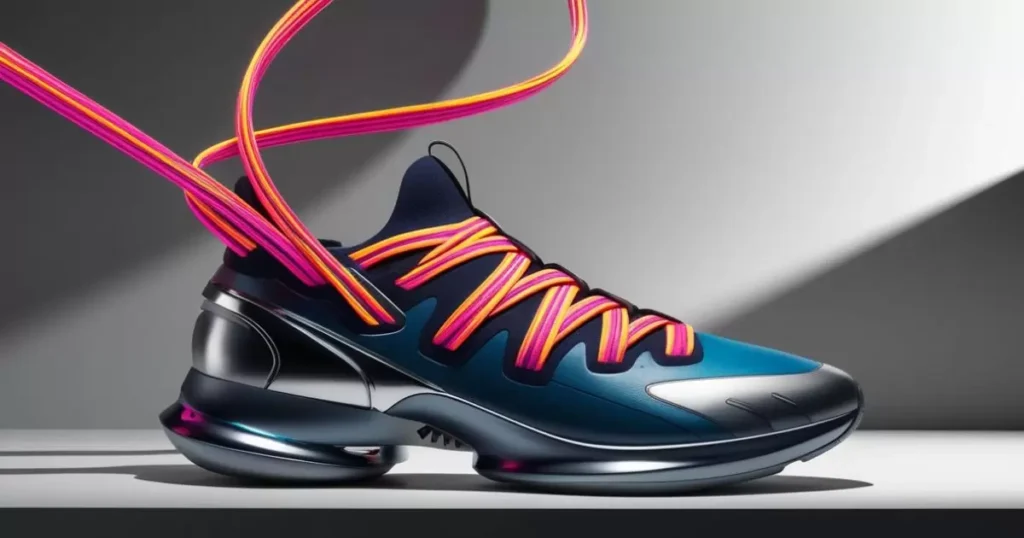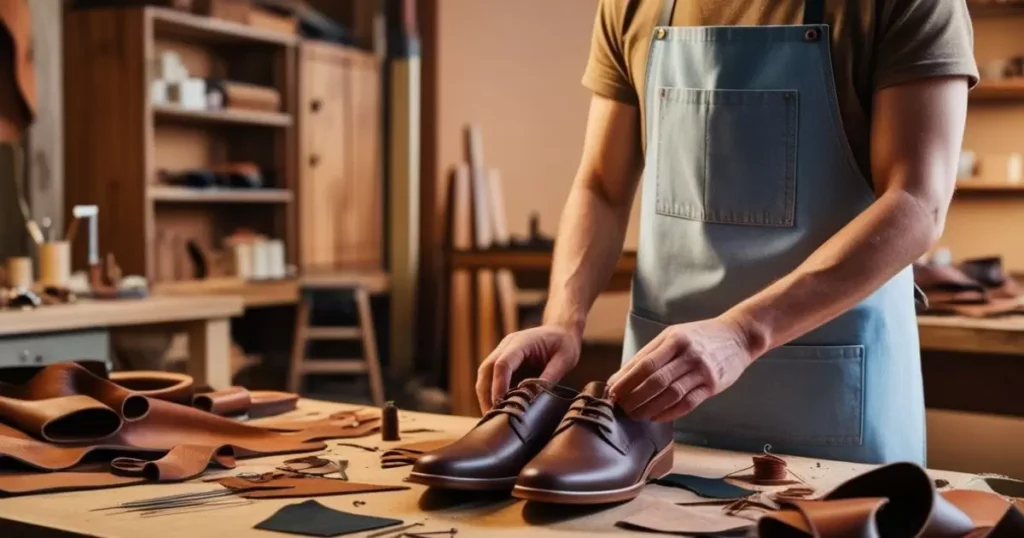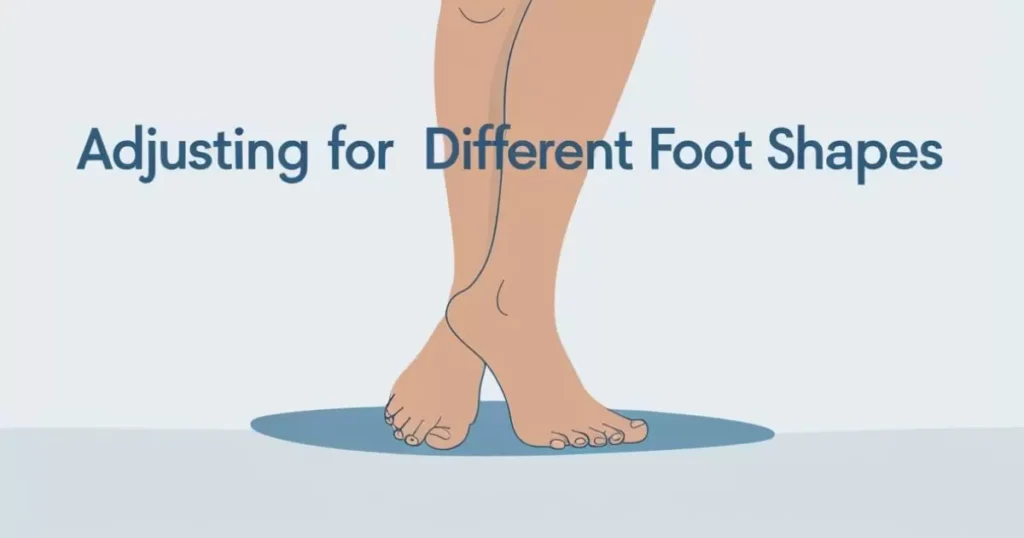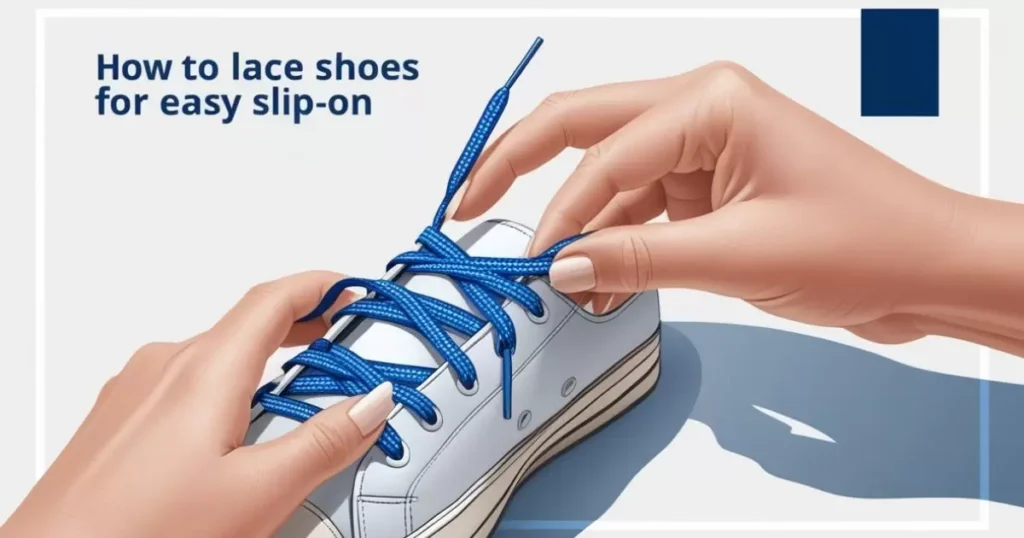Are you tired of bending down to tie your shoes every time you head out? Do you dream of slipping into your favorite kicks without the hassle of laces? You’re not alone. In this comprehensive guide, we’ll explore the art of lacing shoes for easy slip-on access, transforming your footwear experience forever.
Introduction
We’ve all been there – rushing out the door, hands full, only to realize we need to put on our shoes. The daily ritual of tying laces can be a real pain, especially when you’re in a hurry or dealing with mobility issues. But what if there was a better way?
Enter the world of slip-on shoe lacing techniques. These innovative methods allow you to enjoy the support and style of laced shoes with the convenience of slip-ons. In this guide, we’ll dive deep into various lacing strategies, from traditional methods to cutting-edge solutions, that’ll have you wondering why you ever bothered with conventional knots.
Benefits of slip-on lacing include:
- Time-saving convenience
- Easier for those with limited mobility
- Reduced wear and tear on laces
- Customizable fit without daily adjustments
- Sleek, streamlined appearance
Get ready to revolutionize your shoe game as we explore techniques that blend form, function, and fashion.
Understanding Shoe Anatomy
Before we dive into lacing techniques, let’s break down the key components of a shoe. Understanding these parts will help you master slip-on lacing methods more effectively.
Key Shoe Components:
- Upper: The top part of the shoe that covers the foot
- Eyelets: The holes through which laces are threaded
- Tongue: The flap under the laces that protects the top of the foot
- Heel counter: The rigid part at the back that supports the heel
- Insole: The inner layer on which your foot rests
- Outsole: The bottom layer that contacts the ground
Lacing affects more than just how you put on your shoes. It plays a crucial role in fit, comfort, and even foot health. Proper lacing can:
- Prevent blisters by reducing friction
- Improve stability during physical activities
- Accommodate different foot shapes and sizes
- Alleviate pressure points
By mastering slip-on lacing techniques, you’re not just saving time – you’re optimizing your entire footwear experience.
Traditional Slip-On Lacing Methods
Let’s start with some tried-and-true lacing techniques that have stood the test of time.
Straight Bar Lacing
Straight bar lacing, also known as lydiard lacing, creates a clean, parallel look while providing excellent slip-on functionality.
Step-by-step guide:
- Start at the bottom eyelets, inserting the lace from underneath
- Run the lace straight across (bar) to the opposite eyelet
- Insert both ends up through the next set of eyelets
- Create another straight bar
- Repeat until you reach the top, alternating the crossover underneath
Pros:
- Clean, professional appearance
- Even pressure distribution
- Easy to loosen for slip-on use
Cons:
- Can be tricky to adjust tightness
- May not work well for high-arched feet
“Straight bar lacing is my go-to for dress shoes. It looks sharp and slips on easily for busy mornings.” – Tom, corporate professional
This method works best on dress shoes and casual sneakers with an even number of eyelet pairs.
Army Lacing Technique
Developed for military personnel who need to don boots quickly, this method is all about speed and convenience.
How-to instructions:
- Thread lace through bottom eyelets from top to bottom
- Cross laces and feed through next set of eyelets from underneath
- Continue crossing and feeding through eyelets
- At the top, create a loose loop instead of tying
- Tuck excess lace inside the shoe
Why it works: The army lacing technique creates a series of loops that can expand when you insert your foot, then contract for a snug fit. It’s ideal for boots and high-top sneakers.
Innovative Lacing Techniques

Now let’s explore some modern twists on shoe lacing that maximize slip-on convenience.
Heel Lock Method
The heel lock, or lace lock, is a game-changer for athletes and anyone who needs a secure fit with slip-on ease.
Tutorial:
- Lace your shoe normally up to the second-to-last eyelet
- Thread each lace end through the top eyelet on the same side, creating loops
- Cross each lace and thread through the opposite loop
- Pull tight and tie as usual
This creates a pulley system that locks your heel in place while allowing for quick on and off.
“The heel lock changed my running game. My shoes feel like an extension of my feet, but I can still slip them on in seconds.” – Sarah, marathon runner
Loop Back Lacing
This unique approach creates intentional slack in your laces for easy foot entry.
Step-by-step guide:
- Start with traditional criss-cross lacing
- At the midpoint, create a large loop on one side
- Continue lacing normally to the top
- Use the loop to adjust overall tightness
Loop back lacing is perfect for everyday sneakers and casual shoes where you want the option to tighten or loosen quickly.
Hardware Solutions
Sometimes, the key to perfect slip-on shoes lies in additional hardware. Let’s explore some popular options.
Lace Anchors
Lace anchors are small plastic devices that clip onto your laces, holding them in place without tying.
Installation process:
- Lace your shoes as desired
- Thread lace end through the anchor
- Pull to desired tightness
- Clip anchor closed
- Trim excess lace
Pros:
- Extremely quick to use
- Adjustable tension
- Sleek appearance
Cons:
- Can break over time
- May not work with all lace types
Elastic Laces
Elastic laces replace traditional laces entirely, turning any shoe into a slip-on.
Types of elastic laces:
- Continuous elastic laces
- Segmented elastic laces
- Bungee-style laces
Installation tips:
- Remove old laces
- Thread elastic laces through eyelets
- Adjust tension
- Secure with included locks or ties
- Trim excess
Elastic laces are especially popular among triathletes for quick transitions and people with limited hand dexterity.
Custom Slip-On Conversions
For the DIY enthusiasts, here are some ways to permanently or temporarily convert your laced shoes to slip-ons.
Converting Regular Shoes to Slip-Ons

Permanent modifications:
- Remove existing laces
- Install elastic goring on shoe sides
- Sew or glue in place
Reversible techniques:
- Use elastic laces with hidden knots
- Install removable velcro straps
- Create a faux tongue overlay
DIY Lace Locks
Create your own lace locks for a custom solution.
Materials needed:
- Small plastic tubing
- Lighter or heat gun
- Scissors
Creation process:
- Cut tubing to 1-inch lengths
- Heat one end to slightly melt and seal
- Thread laces through tube
- Heat other end to secure
These DIY locks allow you to adjust tension and convert any shoe to a slip-on style.
Slip-On Lacing for Different Shoe Types
Different shoes require different approaches. Let’s break it down by category.
Athletic Shoes
For sports and workouts, you need a balance of security and easy access.
Recommended methods:
- Heel lock for running shoes
- Loop back lacing for cross-trainers
- Elastic laces for triathlons
Dress Shoes
Maintain a professional look while adding convenience.
Best techniques:
- Straight bar lacing
- Hidden elastic laces
- Lace anchors for subtle adjustment
Boots
Tackle tall boots with these slip-on strategies.
Effective approaches:
- Army lacing technique
- Speed hooks conversion
- Zip-up side installation
Children’s Shoes
Help kids gain independence with easy-on footwear.
Kid-friendly options:
- Elastic laces with large toggles
- Velcro conversion straps
- Simplified straight bar lacing
Troubleshooting Common Issues
Even the best slip-on lacing can sometimes need adjustment. Here’s how to tackle common problems.
Dealing with Loose Heels
If your heel slips, try these fixes:
- Implement the heel lock technique
- Use an extra eyelet at the top for more ankle support
- Insert heel grips or pads
Addressing Pressure Points
Eliminate discomfort with these tips:
- Skip eyelets over pressure areas
- Use padding or moleskin on problem spots
- Try asymmetrical lacing patterns
Adjusting for Different Foot Shapes

Customize your lacing for your unique feet:
- High arches: Use gap lacing in the middle
- Wide feet: Start with looser bottom eyelets
- Narrow feet: Utilize the loop back method for adjustability
Maintaining Your Slip-On Laced Shoes
Proper care ensures your slip-on lacing system lasts.
Cleaning Tips
- Remove laces or hardware before washing shoes
- Clean laces separately with mild soap
- Air dry everything thoroughly before reassembly
When to Re-Lace
Consider re-lacing when:
- Laces show signs of fraying
- Eyelets become stretched or damaged
- Your foot shape or needs change
Extending Lace Life
- Rotate between multiple pairs of shoes
- Use lace protectors on high-wear areas
- Opt for durable materials like paracord for heavy use
Expert Opinions
We consulted professionals to get their take on slip-on lacing methods.
Podiatrist’s Perspective
Dr. Jane Smith, DPM, shares: “Slip-on lacing can be beneficial for many patients, especially those with arthritis or back problems. However, it’s crucial to maintain proper support. I often recommend the heel lock method for patients who need a balance of convenience and stability.”
Athlete Testimonials
Olympic sprinter Mark Johnson notes: “I swear by elastic laces for my track spikes. They give me the perfect tension every time, and I can get in and out of them in seconds. It’s a small edge, but in my sport, every second counts.”
Fashion Expert Insights
Style consultant Lisa Wong advises: “For formal occasions, nothing beats the clean lines of straight bar lacing. It’s sleek, sophisticated, and with a bit of practice, just as convenient as any slip-on shoe.”
Conclusion
We’ve explored a world of possibilities for transforming your laced shoes into convenient slip-ons. From traditional methods like straight bar lacing to innovative techniques like the heel lock, there’s a solution for every shoe and lifestyle.
Remember, the perfect lacing method for you depends on your specific needs, shoe type, and personal preferences. Don’t be afraid to experiment with different techniques until you find your ideal fit.
As shoe technology evolves, we can expect even more exciting developments in the world of slip-on lacing. Who knows? The future might bring us self-lacing shoes that adjust to our feet automatically.
For now, armed with the knowledge from this guide, you’re well-equipped to say goodbye to the daily struggle of tying laces. Embrace the freedom of slip-on shoes without sacrificing style or support. Your feet will thank you!
FAQs
Q: Can slip-on lacing work for high-intensity activities?
A: Absolutely! Methods like the heel lock and elastic laces are popular among athletes for providing secure fits with easy on-off access.
Q: How do I choose the right method for my shoes?
A: Consider your shoe type, activity level, and personal comfort preferences. Dress shoes often work well with straight bar lacing, while athletic shoes might benefit from loop back or heel lock methods.
Q: Are there any downsides to slip-on lacing?
A: Some methods may not provide as precise a fit as traditional tied laces. Additionally, certain techniques might wear out laces faster. However, for most people, the convenience outweighs these minor drawbacks.
Q: Can I use these methods on all types of footwear?
A: Most slip-on lacing techniques can be adapted to work with any shoe that has traditional lace eyelets. However, some methods may be more suitable for certain styles. Always test the security of your lacing before engaging in any intense activities.

An author is a creator of written content, producing works ranging from books and articles to blog posts and essays. They use their creativity, knowledge, and research to inform, entertain, or persuade readers. Authors often have a unique voice and perspective, contributing significantly to literature and various media.

